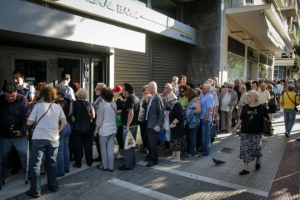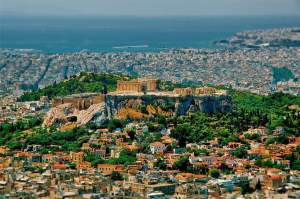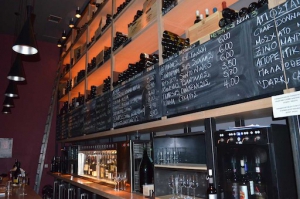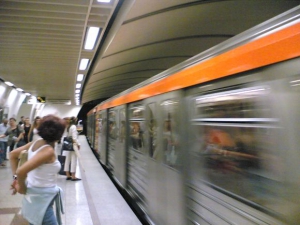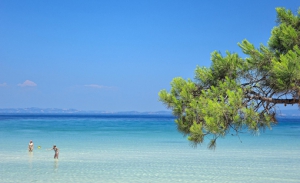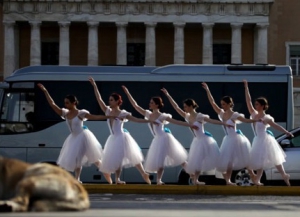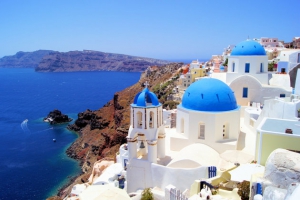LIFE & CULTURE
XpatAthens
Monday, 20 July 2015 12:07
Greek Banks Reopen - € 420 Weekly Withdrawal Limit
Greeks queued outside banks on Monday as they reopened three weeks after closing to stop the system collapsing, the first cautious sign of a return to normal after a deal to start talks on a new package of bailout reforms.
However limits on withdrawals will remain and payments and wire transfers abroad will still not be possible - a situation which German Chancellor Angela Merkel said on Sunday was "not a normal life" and warranted swift negotiations on a new bailout, expected to be worth up to 86 billion euros.
The stock market will also remain closed until further notice. Increases in value added tax agreed under the bailout terms have also taken effect with VAT on food and public transport jumping to 23 percent from 13 percent...
...Limits on cash withdrawals have been made slightly more flexible, with a weekly limit of 420 euros in place of the daily 60 euro limit previously. "Capital controls and restrictions on withdrawals will remain in place but we are entering a new stage which we all hope will be one of normality," said Louka Katseli, head of the Greek bank association.
Greeks will be able to deposit cheques but not cash, pay bills as well as have access to safety deposit boxes and withdraw money without an ATM card.
Bankers said there may be minor disruptions after the three-week interruption to services but they expected services to resume largely as normal. "I don't expect major problems, our network and the network of our competitors are ready to serve our clients," said a senior official at Piraeus Bank, one of the big four lenders. "There might be lines because many people will want to withdraw money from their deposit boxes," the official said.
To read this article in full, please visit: eKathimerini
Published in
Local News
Tagged under
Friday, 17 July 2015 08:00
Summer Sales In Athens: 13 July - 31 August
Summer sales begin on Monday July 13 2015 and run until Monday August 31 2015. The Commercial Association of Athens has suggests that shops remain open on Sunday July 19 from 11 am to 8 pm.
Happy shopping!!
Source (translated by XpatAthens): Express.gr
Happy shopping!!
Source (translated by XpatAthens): Express.gr
Published in
Local News
Tagged under
Friday, 17 July 2015 07:00
Greece Today: Safe, Affordable And More Beautiful Than Ever
A great, positive opinion piece by the Huffington Post.
I was in Greece last week and experienced a country completely different to what was being portrayed on TV, amazed at how political and economic considerations could color the news so darkly. The fear-mongering did not work and Greeks voted overwhelmingly to say No to Europe's impossible demands.
My findings: the Greek people, known for their 'philoxenia' or 'hospitality,' continue to be as warm and inviting as they always have been. Greece has among the largest percentage of repeat visitors in the world and, in the first quarter of 2015, North American visits were up 54%. I say: Now is the best time to travel to Greece. Greece today is safe, affordable - and more beautiful than ever.
Most of us have images of Greece in our minds that range from the Acropolis in Athens to the Islands - more than 3,000 of them. For the past two decades Santorini and Mykonos have consistently won the awards for 'best island' in both the Europe and Overall categories. But Greece is that much and more - our visit inclued Athens, the incredible Isle of Evia, and the majestic mountain region of Karpenisi.
I arranged to visit Greece the week leading up to its historic Referendum. Although I have lived in Europe for several years and written about Greece and Greek-Americans, this was my first visit there. What I was not prepared for was both the warmth of its people and the sunlights - different than any I have experienced anywhere in my travels.
Over three hundered days of sunshine explains why so many activities are enjoyed outdoors. The temperate climate allows for the freedom of walking around and exploring at all hours of the day and night. A Mediterranean Vancouver.
Acropolis
The Acropolis in Athens with its Parthenon is even grander than imagined. Literally meaning the 'highest spot in the city,' it soars about the capital and must have stunned early visitors thousands of years ago. This ancient citadel, located on a high rocky outcrop above the city, features a soaring modern museum at its base.
Evia
The Island of Evia on the Mediterranean in central greece was also an absolute delight. Starting in the capital - Kalkida, we journeyed south for skin and SCUBA diving, and then north for the hot springs, enjoying incredible, fresh cuisine from the garden and sea from one end of the long island to the other. To the sound in Limionas, our group explored the breathtaking underwater Purple Caves, followed by lunch in a traditional Greek taverna.
To read more, please visit: The Huffington Post
by Jim Luce
Published in
Travel Greece
Tagged under
Thursday, 16 July 2015 07:00
Five Of The Best Bars In Athens
A round up of the very best drinking dens in the Greek capital, including the TAF Foundation, the Clumsies, By The Glass, 48 Urban Garden and Galaxy Bar - and drinks that range from cocktails made with white and black rum with pineapple and passion fruit to premium gins and some of Greece's best wines.
Greece may be struggling to find a way out of its economic crisis, but the citizens of Athens still have plenty of choice when it comes to escaping their woes over a drink. Whether you're in town to party or talk politics, here are five great places to drink in the country's capital.
1) taf Foundation
Through a tiny door in the middle of an antique-shop-filled street in Monastiraki is the TAF Foundation - taf is the Greek letter T but in this case also stands for The Art Foundation - a courtyard arts space. The yard is lined with a bar (think high tables and seats, covered in winter and open to the elements in summer) and the whole place feels like sitting in the middle of a film set. The in-house exhibition this summer is of cocktail posters. For each poster, a cocktail: the Hangover is white and black rum with pineapple and passion fruit, Peacock Blues is gin, honey, grapefruit and spearmint. Website (in Greek): http://theartfoundation.metamatic.gr/
2) The Clumsies
New cocktail bar The Clumsies is home to an experimental kitchen where you can find the staff distilling the essence of blue cheese and mixing it with alcohol. The Clumsies created Greece's first premium gin and the drinks list includes a cocktail made with frapa lemon, bitters, oregano and rosemary. Speak to the bartender and he or she will customize your drink to your tastes. Vasilis Kyritsis, one of the owners laughs, "A friend observed that we spilled a few things behind the bar, but we say the right way is to be a little bit clumsy!"
3) By The Glass
By The Glass offers the best of Greece's modern wines - fabulous whites, roses and reds. Sit in the arcade or inside at one of the high tables and try the tiny 25ml measures, or 'by the glass,' or full bottles. As the name suggests, a special sealing method is used to make every bottle in the house available by the glass. Food to compliment each of the wines is also available. Website: http://www.bytheglass.gr/#!home-en/c1lvn
To read more, please visit: Olive Magazine
by Audrey Gillan
by Audrey Gillan
Published in
Pubs, Bars & Cafes
Tagged under
Wednesday, 15 July 2015 07:00
No More Free Public Transport In Athens
Commuters in the Greek capital will have to pay their regular fare when travelling along Athens' Public Transport Network as of Wednesday, 15th July 2015 when the temporary measures of free public transport ceases to apply.
It is reminded that public transport (metro, electric railway, tram, buses and trolleys) in Athens was free since June 29th once the Greek government launched a "bank holiday", which remains in force.
Source: Greek Travel Pages.
Published in
Local News
Tagged under
Monday, 26 December 2016 07:00
Top Six Family Destinations
If you have already visited Greece for your holidays, then you are fully aware of how your children can really have the time of their lives here. But if this is your fist visit, here's a list we’ve made for you to choose your favourite family destination! Either way, mums and dads, be prepared to relax and have a good time in a country where family is still a strong bond that holds us Greeks together!
'Paidiá, kalosírthate!' (Children, welcome!) is what you and your children will hear when you come to Greece. Your family holidays begin with a hearty, warm welcome in a country where children can enjoy memorable adventures in the past and present. Here, they will find themselves in places where their favourite heroes lived, like Xena, Hercules, Alexander the Great, and the 300. They can learn about Troy and run around the track at the birthplace of the Olympics.
But, let’s see what else your children –and you, of course– will love in Greece:
• sunny sandy beaches with crystal-clear waters and azure seas filling rocky coves and caves
• classic ruins in romantic settings
• olive, orange and lemon groves and important nature reserves
• delicious kid-friendly food cooked with the most nutritional ingredients of the Mediterranean diet: virgin olive oil, fresh fish, fruit and vegetables, etc.
• water parks, beaches and spectacular swimming pools open all day long, and
• above all, safety and warm hospitality.
Ok, it’s time to present you with our selection of Greece’s summer destinations which we think will live up to your family’s expectations.
Here are just six Greek islands to help you get an idea of how you and your family could spend your summer vacations in Greece!
Rhodes (Rhódos)
Where: In the Aegean Sea, part of the Dodecanese island group.
Why: One of the most visited Greek islands teeming with history and adorned with numerous sandy beaches, most of which have been awarded Blue Flags thanks to their excellent water quality, environmental management, and safety.
Must visit: The beautiful medieval city of Rhodes, the ancient town of Líndos, the castles near Monólithos and Kritinía, the other Dorian city-states of Kameiros and Ialyssos, and Prassoníssi, one of the best windsurfing spots in Europe.
Where to stay: At family-oriented resorts with numerous swimming pools, open-air theatres where children’s plays and music and dance extravaganzas are organised daily, or smaller guest houses scattered around the island, in the villages, near secluded beaches.
Where to stay: At family-oriented resorts with numerous swimming pools, open-air theatres where children’s plays and music and dance extravaganzas are organised daily, or smaller guest houses scattered around the island, in the villages, near secluded beaches.
Join in with: Music, cinema, art and dance festivals, and the medieval festival held in September.
An extra tip for kids: Visit the Aquarium and Butterfly Valley.
An extra tip for kids: Visit the Aquarium and Butterfly Valley.
Corfu (Kérkyra)
Where: In the Ionian Sea, part of the Ionian group.
Why: Often called the “Garden Isle”, Corfu is full of olive groves, cypresses, bushes, colourful anemones, orchids and a number of endemic flowers. Even the long sandy beaches provide a good example of marine flora. During the summer, electric blue thistles, sea squill (of the lily family) and flowering shrubs bloom.
Must visit: The beautifully preserved Old Town of Corfu, a UNESCO world heritage site, filled with Venetian, French and British monuments and remarkable works of architecture. The sites that used to be the old aristocracy’s favourites: Mon Repos and Achilleion Palaces, Paleópolis, etc.
Where to stay: Five and four-star hotels offer accommodation specially designed for families and daily activity programmes to entertain children (such as competitions, animation programmes, etc.). Family-run, beachfront guesthouses also offer all the comforts you and your family need.
Join in with: The International Corfu Festival dedicated to promoting the rich musical heritage of the island. Concerts are held in Duomo, Achilleion Palace, the Fortress, several museums and art cafés.
An extra tip for kids: Enjoy your favourite cartoon movies at the open-air summer cinemas in the city.
Okay, we’re cheating here! Halkidiki isn’t actually an island. It’s a peninsula on the mainland jutting out into the sea. But with so many superb beaches, it feels like an island!
Where: a peninsula in northern Greece, part of Central Macedonia
Why: Halkidikí is home to countless superb beaches, almost all of them blue flag winners, lush green forests and a rich gastronomic and cultural heritage.
Must visit: Mount Athos (unfortunately, no women allowed), the cave of Petrálona, one of the most important caves in Europe, Stágeira, the home land of Aristotle.
Where to stay: Rent a room in a traditional seafront guesthouse, or choose from a wide selection of major hotel complexes. There also hotels that offer specially organised activities for youngsters of all ages (from 4 months to16 years old), so that parents can enjoy spa treatments while their kids are being looked after by specialist child minders. Special prices depending on your child’s age are also on offer.
Join in with: Open-air festivals that feature world-class jazz, classical, ethnic and folk music.
An extra tip for kids: Enjoy pool games and water polo in pools specially designed for you!
To read more, please visit: Visit Greece
Published in
Kids Life
Tagged under
Monday, 13 July 2015 07:00
Greek Leek Pie - Prasopita
Often thought of as a British dish, this pie tastes delicious with feta cheese and philo pastry.
Don't use the dark green part in the cooking of this recipe, unless you want a stronger flavour.
Don't use the dark green part in the cooking of this recipe, unless you want a stronger flavour.
Leeks are of the onion/garlic family and the reason for cutting them down the middle and rinsing the insides is to rid them of dirt.
Ingredients
- ⅓ cup olive oil
- 2-3 medium leeks, cleaned (see video) and chopped - you’ll need 3 cups chopped*
- 1 shallot, diced
- 2 garlic cloves, pressed
- salt
- pepper
- ½ teaspoon chopped dill
- 1 tablespoon chopped parsley
- 1 cup crumbled feta
- ½ cup shredded parmesan
- 2 eggs
- 1lb box phyllo**
- ⅓ cup butter, melted
To read more and to see a video preparation, please visit: Lemon & Olives
Published in
Greek Food & Diet
Tagged under
Tuesday, 14 July 2015 07:00
Moving Athens: Inspiring Short Dance Film Portrays A Changing City
On Syntagma Square in Athens, Greece, six young ballerinas in full Giselle costume execute graceful romantic sequences in the midst of traffic, whilst on Omonoia Square, traditional Black Sea dancers, their hands clasped, dance rhythmically in file next to rushing buses and perplexed passers-by. Is this a protest of a different kind? For director Jevan Chowdhury, these images from his latest film Moving Cities: Athens could be read as such; for him, and many others, dancing in public spaces is an act of sovereignty.
Chowdhury launched his Moving Cities project in 2014 as - he told Yatzer - a ''collection of cities that are interesting or significant today.'' Following Paris, London, Brussels, Yerevan and Prague, the Moving Cities project travelled to Athens, Greece, in January 2015 where, over the course of three days, some 60 dancers were filmed improvising in the city’s streets, squares, back yards and rooftops. In the monochrome style and constantly moving camera flow that is consistent throughout the Moving Cities project, Chowdhury’s film visits several locations across the city, from the busy Piraeus port to the touristy Acropolis, accompanied by a powerful music score by composer Danny Odom.
For Chowdhury, ''the locations were very important .....All the dancing you see in the video was the result of the location. We did a casting in collaboration with the Athens Video Dance Project (AVDP), got in touch with several dancers and asked them to respond to certain locations through dancing. This way the dancers tapped into the atmosphere of the place and also expressed in their own way how they felt at that particular time. I chose mostly tourist areas because they are very transient places, but also quite generic in a way. Because these films are also a reference to how all the cities we live in are the same, and how it’s actually the people that make the difference.'' To read more, please visit: Yatzer
Published in
Videos
Tagged under
Monday, 13 July 2015 07:00
What Travellers Need To Know About Visiting Greece
Greece's debt crisis is making headlines around the world, but that doesn't mean the country's tourism industry is crubmling, experts say.
Major banks in Greece are closed, and citizens face restrictions on ATM withdrawals in light of the country's economic crisis, the latest of which involved a rejection of a bailout deal. Withdrawals of cash are limited to €60 per Greek citizen per day, though that amount may decrease in coming days.
But travelers should be able to enjoy their vacations in Greece without major problems.
First of all, foreigners are not subject to the same ATM withdrawal restrictions. "So far, tourists in Greece have been unaffected by recent economic developments," Christos Stergiou, founder of Greek luxury travel company True Greece, told the Huffington Post. "Foreign credit cards continue to be functional, even with the banks closed."
As a precaution, Stergiou says visitors to Greece should arrive with the full amount of Euros they'll need in cash, as ATMs may run out of money or have long lines. He also suggests that visitors use credit cards whenever possible during their stay.
To read more, please visit: The Huffington Post
Published in
Greece In The News
Tagged under
Friday, 10 July 2015 01:07
My Week Of Uncertainty
It has been a couple of weeks since I last wrote anything in this space - and what a couple of weeks it has been... Apart from the total confusion and uncertainty that I think all of us have experienced, I have personally experienced a range of emotions, unlike any I have felt before. What does the expat community make of everything that is happening in our adoptive home?
What stands out for me, beyond the material impact of profound crisis, is the intensity of what I have been feeling for the past 10 days. I was raised in Canada, a place where crisis seems impossible, where the system is never far from 'perfect', where 'intense emotionality' reads as cursing under your breath when someone breaks the speed limit.
So to live in Greece during the past weeks has been nothing short of jaw-dropping for me. There have been moments where I just sit motionless, unable to think clearly or act. Like, how is this all possibly happening? What's coming next...?
I learned early on that intensity of emotion was a basic part of life in Greece - from screaming matches with taxi drivers who cut you off to the daily screaming matches on television news to the life-ending reactions when January temperatures hit 0 degrees. Greece is not a land of subtle response. But until the events of the past week, I've experienced this mostly as an observer.
This week... I've felt sad, frustrated, shocked, angry, afraid, tired, confused, ashamed, panicked - intensely so, and often all at once. I am completely emotionally drained. Writing this, all I want to do is sleep. Reading the wide variety of (mis)information and opinions from various news sources and social media - including those of people who have never set foot in this country, and those of people who have never set foot outside this country - made all the above much (much) worse. And this from a guy who has the luxurious option of hopping on a plane and going back 'home' at any moment. I worry deeply about the societal costs of all this 'crisis', the impact on the nervous system of a nation and a culture...
I'm not sure where all this will lead - nor even where I think it should lead. Maybe everything gets somehow fixed next week; maybe we all wake up back in Kansas; maybe 'it gets better', as the saying goes... And maybe it doesn't.
There has been an eerie calm around town the last few days, like we are collectively holding our breath waiting for the next act to begin. If I am the example, then we are simply drained and have used up our reserves of 'intensity'... Who would have thought that possible in this country? Maybe we are just resigned to accept whatever happens next, too exhausted to do anything else...
While I waited in the ATM line to get my €50 early this morning, I recalled some of the reasons I moved here in the first place: to feel the sun on my skin, to dive into the sea as often as possible, to soak in the beauty of the land, to be part of a unique and ancient culture, to experience life more fully, to feel intensely. Κουράγιο...
Until next week,
Jack
Published in
My Week In Athens
Tagged under

